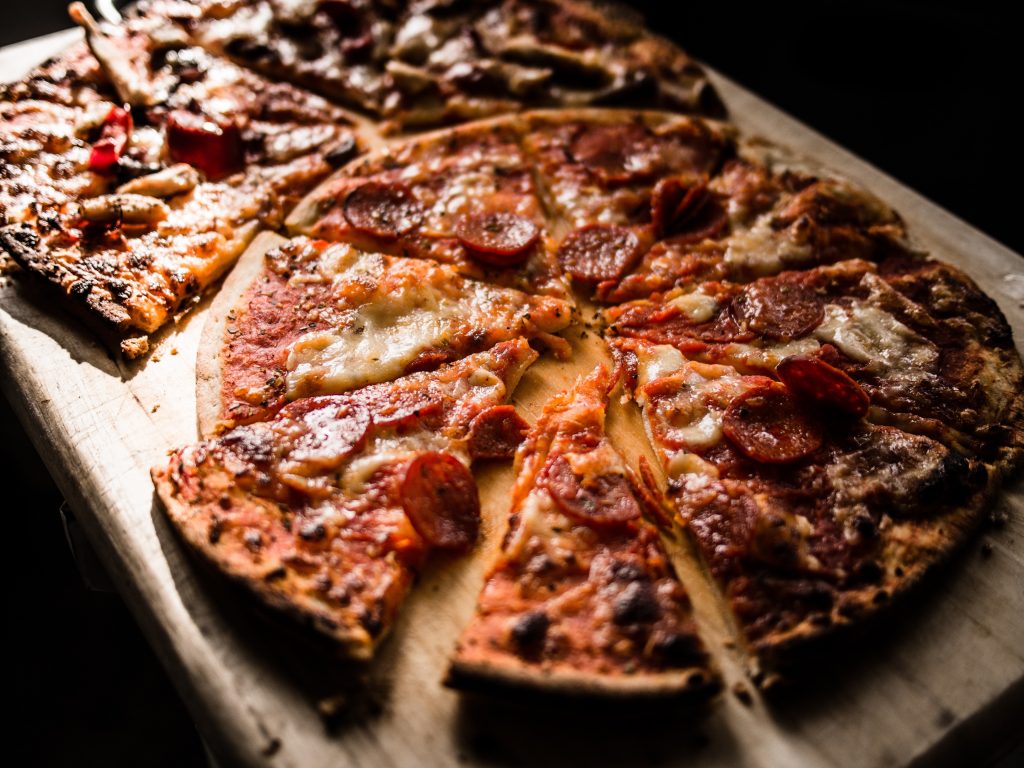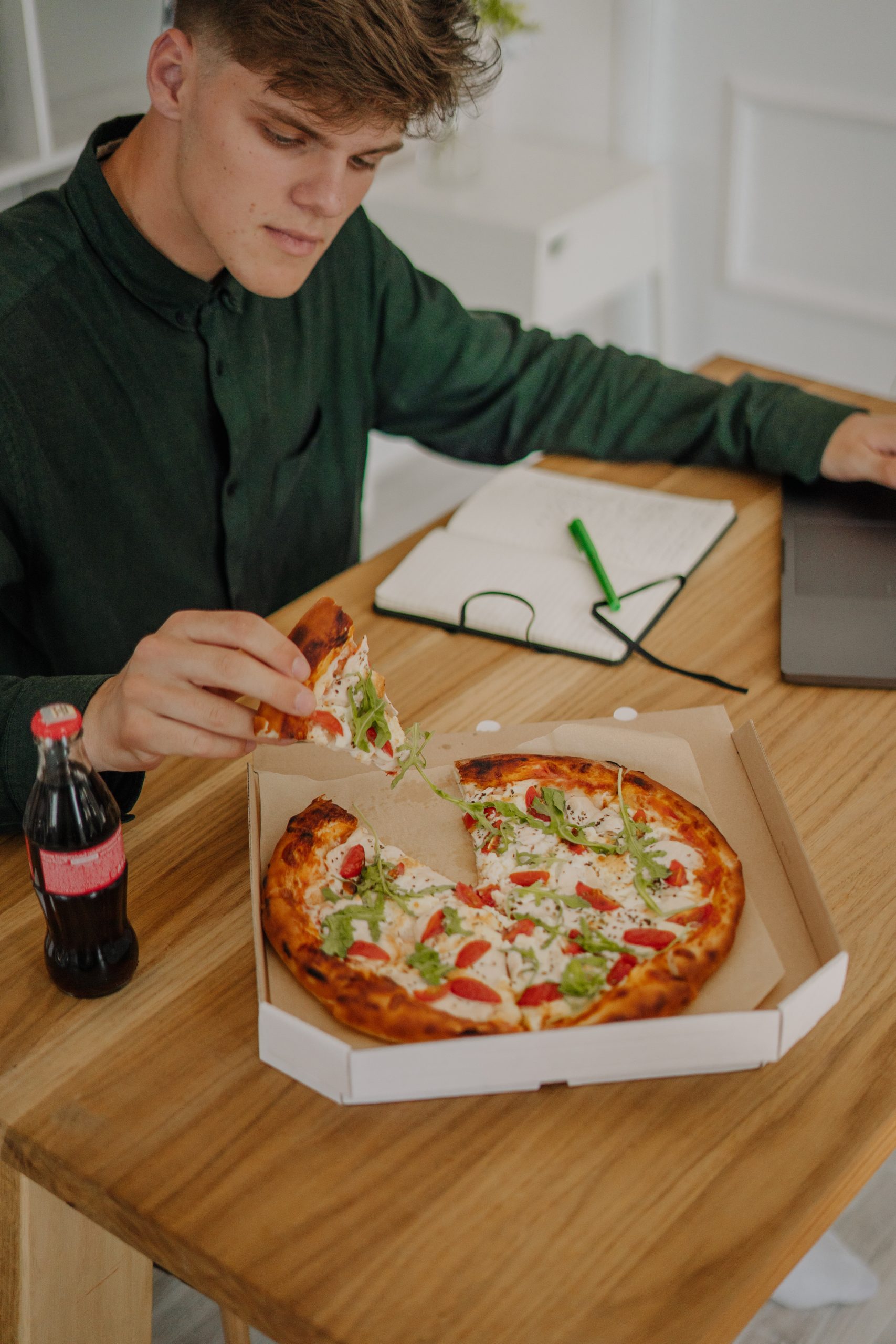When you’re preparing your pizza you’ve probably wondered which order your tomato, cheese and toppings should go. Sometimes this is actually a hotly debated topic depending on where you are in the world.
So should you put the cheese or tomato first? Do you put toppings or cheese on pizza first? When making pizza what goes on first?

Typically tomato sauce will go on first on top of the dough, then cheese and then toppings. This allows the cheese to bubble and brown and the toppings to get direct heat and become crisp. There are some exceptions where the cheese is put first, or the toppings are put under the cheese but these are only certain pizzas.
Lets discuss why this is and what are the exceptions. I’ve got some instructions on how to properly top a pizza too. If you are in need of a reliable dough recipe then check out my pizza dough recipe which has all the instructions.
Why Top The Pizza In This Order
Probably the most important is the texture and flavor which is improved with the right order. With the cheese and toppings at the direct heat they get toasted. Cheese that has been toasted gets a deeper flavor and crispy texture. No one wants raw, mushy cheese on pizza.
Presentation is also important. By adding the toppings last then you can easily see what is on the pizza and makes it look appetizing. This wouldn’t be the same if you buried the pizza toppings under the cheese.
Pizza just looks better when the toppings are over the cheese. You can easily identify what is on the pizza and the eye catching colors of the toppings will make the pizza look very appetizing.
In addition to just looking better, having pizza toppings on top of the cheese can prevent the toppings from getting soggy and mushy. If the toppings go under the cheese, they will be steamed and rapidly cooked when the pizza goes into the oven. The heat from the oven will cause the toppings to release water vapor as they cook. This water vapor will get trapped under the cheese, causing the toppings to steam themselves.
If you put pineapples under the cheese, you will get pineapple mush. If you put pepperoni under the cheese, you may have some soggy pepperoni on your pizza. Many pizza toppings should not be steamed. So, if you want to avoid mushy toppings, keep them on top of the cheese when they can cook and crisp in the oven.
My best tip for making crispy pizza in a home oven is using a pizza “steel”. This adds intense heat from below like a brick oven would – I have this steel from Amazon which is significantly lower priced than the original brand, but works perfectly. Steel is more conductive than stone so transfers more heat, they don’t shatter and they are easier to clean. If it’s out of your price range then the 2nd best option is a pizza stone made from cordierite.
To see a round-up of the most important pizza equipment then see my essential pizza equipment list.
Lastly, the order comes down to ease of use. It is much easier to spread the liquid tomato sauce on a blank pizza base rather than spread it evenly over cheese and toppings. So you can get a nice even layer of tomato sauce.
Problems with this order
The main problem you can get by adding wet tomato sauce directly onto the pizza dough is a soggy pizza base. The dough will absorb water and become less crisp in the oven.
To avoid this you can make a water proof barrier by using sliced cheese on the base first. On top of this you put your layer of tomato sauce (easier to apply on cheese slices) and then toppings. You don’t get the advantage of toasted cheese on the pizza topping, but you can add some grated Peccorino or Parmesan when it comes out of the oven for a great finish.
Exceptions Where Cheese Goes On First
There are several pizza which have the cheese on first. Sicilian style pizzas put the cheese directly on the pizza crust and then the sauce goes on top. This style is common in Chicago, New York tomato pie, as well as many other parts of the USA. The idea behind this method is that the crust cooks better without the wet sauce directly on it.
The Sicilian pizza is deeper and cooked in a tray, almost like a Focaccia with toppings on. It is traditional to put the cheese on first. This helps the thick bread-like dough underneath to not become soggy.
Where Should Toppings Go?
Unfortunately, the answer is a little more complex than you may have thought and it all revolves around what toppings you are choosing to put on your pizza.
The main thing to think about when deciding when to put toppings on a pizza is how the toppings will hold up in the oven. When you bake a pizza, you use a very hot, dry oven which can cook foods very quickly. This high heat will have a great effect on your toppings, especially if they are placed on top of the cheese.
If you have ingredients that are very sensitive to hot, dry temperatures, you will want to bury them under the cheese on the pizza, protecting them from the oven heat. Think about it this way- if you put your favorite pizza topping on a sheet tray all by itself and placed it in the oven, what would happen? Would it burn quickly? Would it get dry and crunchy? Or would it stay soft and tender, allowing the oven to enhance it’s taste?
The answers to this question will determine when to put the topping on the pizza. Toppings that will get dry and burn, hide under the cheese. Pizza toppings that benefit from heat, keep on top of the cheese.
So, as a general rule, consider if your toppings will become dry and crisp when exposed to the hot oven. If so, they should be buried under the cheese. If the toppings will hold up well to the heat, put them right on top of that cheese!
Of course, you can cook the toppings first, separately from the pizza and give them some moisture and resistance to the heat. If you do this extra step, they can definitely go right on top of the cheese.
How To Top A Pizza Properly
Start with my pizza dough recipe which you can find here.
1. Stretch out your dough on a flat worktop with some flour and semolina. Using your hands is better than a rolling pin. You can turn and stretch outwards on the worktop or pick it up and help gravity stretch it over your fists. Place it on top of your peel with some flour.
2. Add your sauce in a circular motion. Then add your cheese and then the toppings. You don’t need too many toppings when cooking fresh dough, so don’t overload it. Be careful not to get sauce on the peel as the moisture will make the dough stick. Periodically give it a small shake to make sure it hasn’t stuck.
3. Open the oven and transfer the pizza to the stone with a swift back-and-forth wrist action to drop the pizza on the stone. Think of it like the magic trick with the table cloth – pulling back quickly and confidently. Try not to angle the peel down too much otherwise the edge of the dough will get caught on the hot stone, and your toppings will fall off.
Conclusion
While it is typically best to put the tomato sauce before the cheese, and the toppings on your pizza on top of the cheese, there are a few exceptions to this rule as you have just seen.
Consider the effect the dry oven will have on the toppings in order to decide if they should be tucked under the cheese or piled up high on top. After making a few pizzas covered in toppings, you will surely be a pizza topping expert.
You should also give the Sicilian style pizza a go and put the cheese on the base first. This pizza is one of my favorites, and is great when cooking for a crowd
